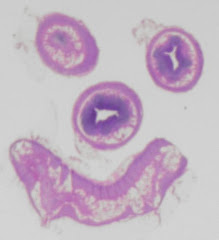1. If the anonymous pathologist would like to participate in a dialogue, please identify yourself. We can continue in a less public conversation if you wish. I welcome your comments (and welcome the opportunity to converse on the subject) but the wording of them is intended to induce a response (a dialogue).
2. Clearly, there are unrealistic expectations being put upon PAs (locally). If what is desired is simply to retain, or regain, the status quo (no PAs), negativity will prevail. If fault is sought, it will be found. If the introduction of PAs is viewed as an opportunity and a challenge rather than an impediment, good things may be realized. PAs are here -- to stay, I hope. I'd suggest that the best of this purportedly 'bad' situation be made for the public's, if not for the hospital's, the department's or even the pathologist's sake. A look at the rest of the continent, at medium- and large-scale teaching organizations, may serve to illustrate the type of relationship that exists between pathologists, clinicians and PAs. Rather than attempting to ostracize, criticize and isolate the PA(s) with whom you are forced to work, include them so that they may be aware and informed. I doubt that the relationship that pathologists have with histotechs (with whom they interact many times each day; both as friends and fellow professionals) could be interpreted as "baby sitting." Au contraire, there are many real friendships that have sprung up between pathologists and histotechs. Yet, the PA sits alone in the grossing room awaiting the next critical comment; usually several days after the grossing of the specimen ("Why didn't you take sections of...?!). How about being proactive? A pathologist (the same pathologist who would be responsible for grossing or frozen sections) ought to be responsible for the goings-on in the gross room and ought to visit EACH morning to review the complex specimens with the PAs and to be available throughout the day to field questions from the PAs. If nothing else, the pathologist and the PA will become acquainted. More importantly, this sets up a teaching environment wherein the pathologist can answer questions and give direction to the PA.
Manuals are finally being created for the area. The pathologists will be asked to provide input into the first round of revisions of the policies and procedures. The manual will be used by whomever (PA or pathologist) is performing the gross and this standardization will go a long way towards an overall improvement in the quality of the surgical pathology 'product.' The manual, in and of itself, acts as an instructional document for the PAs as it will also attempt to give insights into why specimens are handled and sectioned in a particular manner. A means by which the pathologists may become proactive is by becoming involved in the discussions surrounding the wording of the procedures. As the Interior migrates toward an educational environment, these manuals will also serve as invaluable resources for pathology residents (who, like PAs, may be reluctant to admit that they have a lot to learn and who would far prefer to consult a manual than, heaven forbid, ask the pathologist and admit that they were overwhelmed by the flood of information when the pathologist explained how to describe and section a specimen the first time -- remember when you were a resident?). Needless to say, manuals are an absolute requirement of any quality-based facility -- something that many of us are becoming more and more deeply involved in -- and for good reason. "Document what you do" (namely, create a manual) and "Do what you document" (namely, abide by the manual).
PAs care as much about the patient (and about their continued employment) as any healthcare professional. Given the right tools and knowledge, they will perform their task with the same level of excellence as the others with whom they work each day.
Sunday, December 17, 2006
Subscribe to:
Post Comments (Atom)



I hope the PA'S are not here to stay-they create more work than they are worth...for everyone involved!
ReplyDelete